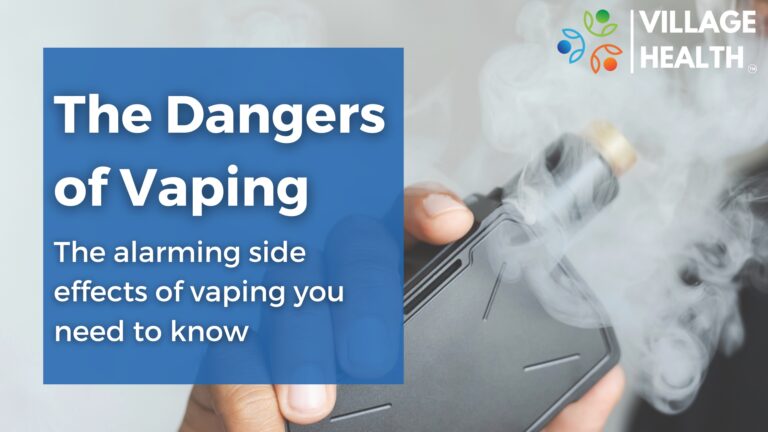
Vaping is the act of inhaling and exhaling vapor produced by electronic cigarettes or other vaping devices. Vaping has become increasingly popular in recent years, particularly among younger individuals, and while some people view vaping as a safer alternative to smoking traditional cigarettes, the reality is that vaping can come with a host of negative health side effects.
Nicotine is a highly addictive substance, and many e-cigarettes and vaping liquid manufacturers market their products with flavors and other additives that are appealing to young people. This has led to a rise in youth vaping and a corresponding increase in nicotine addiction among teenagers and young adults. In November 2022, FDA and Centers for Disease Control and Prevention (CDC) released federal data from the 2022 National Youth Tobacco Survey (NYTS) on youth tobacco use. Findings showed that in 2022, more than 1 in 10 middle and high school students (3.08 million) had used a tobacco product during the past 30 days—including 16.5% of high school and 4.5% of middle school students. Further results showed that current users (nearly 85%) used flavored e-cigarettes, with fruit flavors being the most popular, followed by candy, desserts, or other sweets. Additionally, more than a quarter (27.6%) of current youth e-cigarette users use an e-cigarette product every day.
While the amount of nicotine inhaled during vaping is generally lower than in traditional cigarettes, it is still addictive and can lead to various health problems. Many toxic chemicals can enter the body and cause harm to vital organs, including the lungs, heart, and brain. The liquid in a vape product contains a combination of ingredients, usually including propylene glycol, vegetable glycerine, and flavoring. Many of these substances are considered safe for ingestion, however, when these liquids are heated they can create chemicals like formaldehyde and other contaminants such as nickel, tin, and aluminum.
One of the most significant health risks associated with vaping is its negative impact on respiratory health. The vapor produced by e-cigarettes and other vaping devices contains a number of harmful chemicals, including nicotine, heavy metals, and ultrafine particles that can be inhaled deep into the lungs. These chemicals can cause inflammation and damage to lung tissue, leading to a range of conditions like chronic obstructive pulmonary disease (COPD), asthma, and even lung cancer.
Vaping has also been linked to cardiovascular disease. Nicotine and the other chemicals found in vaping liquids can cause an increase in heart rate and blood pressure, putting undue stress on the heart and circulatory system. This can increase the risk of heart attack and stroke. Researchers from the Cardiac and LUng E-cig Smoking (CLUES) Study noted that their findings were particularly concerning because the negative impact on cardiovascular function among the people who vaped was similar to the impact on the people who used combustible cigarettes, even though those who used e-cigarettes were younger (average age of 27.4 years vs. 42 years, respectively) and had vaped for nearly two decades less than the other group smoked (average 4.1 years vaping vs. 23 years smoking).
Additionally, vaping has been proven to have negative effects on oral health. The chemicals in e-cigarettes can damage the gums and teeth, leading to gum disease, tooth loss, and other oral health problems. Nicotine, whether smoked or vaped, restricts blood flow to the gums, which can contribute to periodontal disease. The fluid in e-cigarettes only increases the risks. A study published in 2020 showed that 43% of people using e-cigarettes had gum disease and oral infections. That figure was higher among smokers (73%) but only 28% among people who neither smokes nor vaped.
Dr. Crystal Stinson, assistant professor at Texas A&M College of Dentistry in Dallas, said in an article from the American Heart Association, “Periodontal disease is normally an adult disease, and we’re seeing it in younger people.” She also notices more cavities in her younger patients who vape, which she believes may be due to the acidity of the components in vape liquid and an increase in cavity-causing bacteria.
So how do I quit vaping?
Given the risks, it is essential to advise people against vaping. If you are currently vaping, it is never too late to quit. There are many resources available to help individuals quit vaping, including nicotine replacement therapy, support groups, and counseling. When a person is dependent on (or addicted to) nicotine and stops using it, their body and brain have to get used to not having nicotine. This can result in temporary symptoms of nicotine withdrawal. Nicotine withdrawal symptoms include:
- Irritability
- Restlessness
- Feeling anxious or depressed
- Trouble sleeping
- Problems concentrating
- Craving nicotine
People may keep using tobacco products to help relieve these symptoms. Many may turn to vaping to try to deal with stress or anxiety, creating a cycle of nicotine dependence. But nicotine addiction can be a source of stress. The first step to giving up vaping is establishing why you want to quit and establishing a start date to do so. Here are some tips to help you pick a quit date:
- Give yourself time to get ready. Getting ready can help you feel confident and give you the skills you’ll need to stay quit.
- Don’t put it off for too long. Picking a date too far away gives you time to change your mind or become less interested in quitting. Choose a date that is no more than a week or two away.
- Set yourself up for success. Try not to pick a quit date that will be stressful, like the day before a big test.
You can expect the first few weeks of quitting vaping to be the hardest. It’s important to remember to take it one day at a time. You may face some challenges after quitting, but knowing what to expect and being prepared can help.
- Learn your triggers. Certain people, feelings, or situations can cause you to want to vape. It’s important to know your triggers. It may be best to avoid situations that can trigger you to vape when you’re in the early stages of your quit.
- Prepare for cravings and withdrawal. Think about how you will fight cravings and deal with withdrawal symptoms. Knowing what to expect and having strategies for handling thoughts about vaping or uncomfortable feelings will help you succeed and stay with your quit in those tough moments.
- Resist temptations. Avoid places and situations where others are vaping. If you can’t avoid being around vaping, plan for how you will handle these situations. Maybe that means you take a temporary break from friends you vape with and think about what you will say if somebody offers you a vape.
While vaping may seem like a safer alternative to traditional cigarettes, it still poses significant health risks. If you are currently vaping, it is vital to consider quitting and seek out the necessary support to do so. If you have never vaped before, avoid starting. If you are a parent or guardian, talk to your children about the risks of vaping and discourage them from trying it. By taking these steps, we can work to reduce the harm caused by vaping and promote better health for all.







